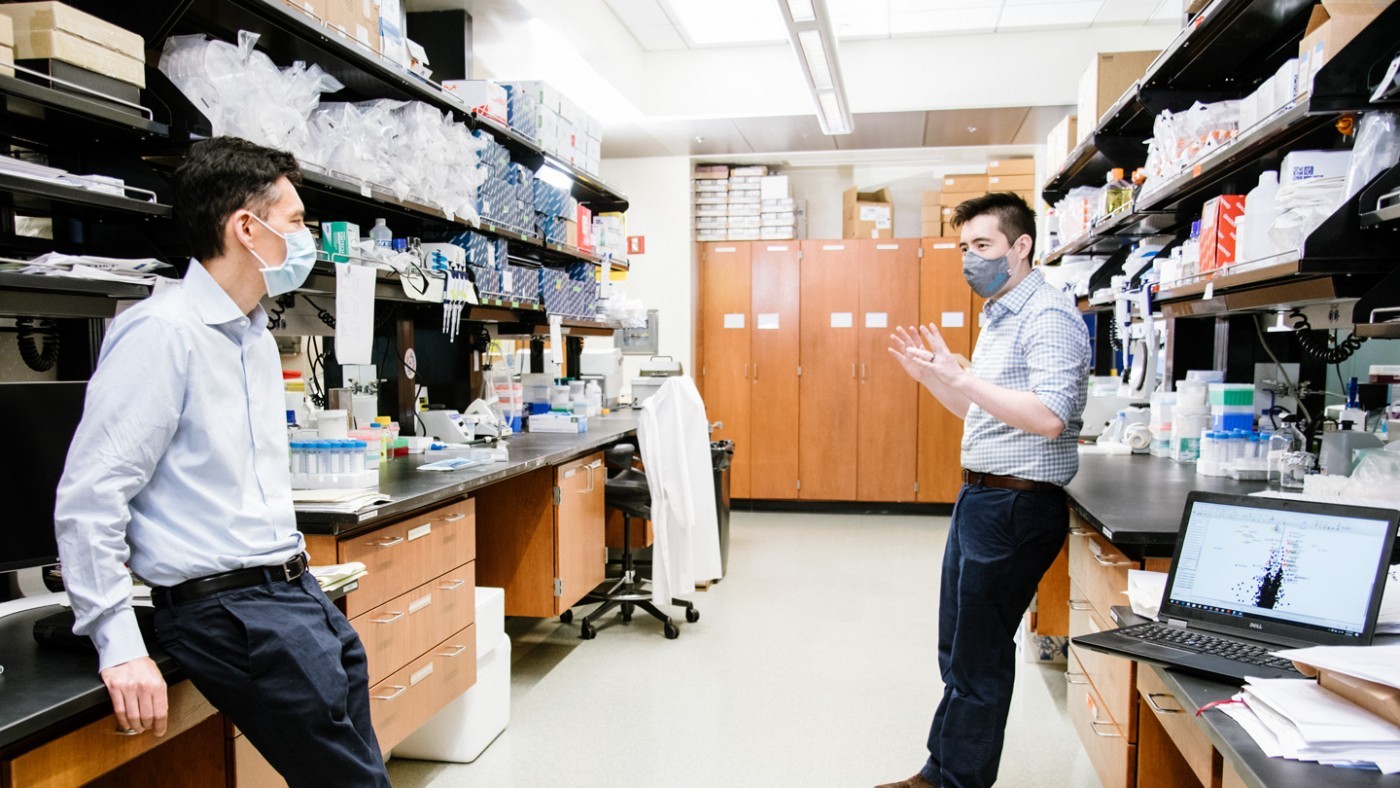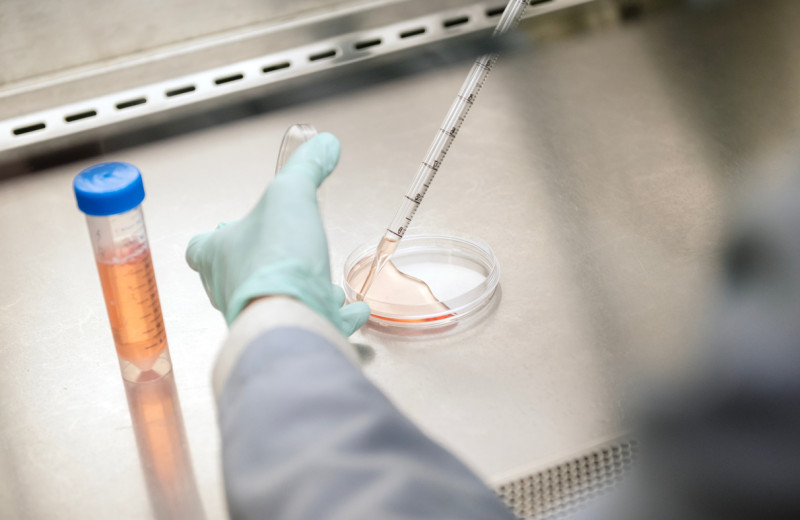Gladstone NOW: The Campaign Join Us on the Journey✕

Ken Nakamura (left) and Neal Bennett (right) screened the human genome to discover how cells control energy production and consumption.
Adenosine triphosphate, or ATP, is the cellular energy currency that is as valuable to the human body as the dollar is to the US economy. Too high or too low levels of ATP in some cell types have been linked to a variety of diseases. However, scientists have lacked an understanding of how cells regulate ATP levels on a broad scale and how cells’ energy levels can be protected or restored in the setting of disease.
Now, researchers at Gladstone Institutes have performed a massive and detailed cellular energy audit; they analyzed every gene in the human genome to identify those that drive energy production or energy consumption. The result is a collection of data they call the “ATPome,” which not only provides new directions for the field of metabolism research, but also identifies genes and proteins that can be targeted to manipulate cellular energy and treat disease.
“Essentially all cellular functions require energy but, before our study, we had very little knowledge about how to restore energy to cells when levels have gone awry,” said Gladstone Associate Investigator Ken Nakamura, MD, PhD, the senior author of the study published online in the journal Nature Communications. “Our findings have implications for treating a broad array of disorders, including neurodegenerative diseases such as Parkinson’s disease and Alzheimer’s disease, mitochondrial disorders, heart disease, diabetes, and cancer.”
When cells need energy, they turn the energy you consume in food into ATP molecules. Then, the cell breaks apart the ATP molecule to release the energy, which is used to fuel chemical reactions. When cells don’t have enough ATP, disease can result. Dysregulated energy production may also play a central role in some cancers. But a lack of understanding of how cells regulate energy has made it difficult to target these energy imbalances therapeutically.
In the new study, Nakamura and his colleagues leveraged a screening approach they had previously developed that uses a chemical sensor to quantify how much ATP is present in individual cells. In addition, they turned to CRISPR gene-editing technology to selectively turn down—or turn up—the expression of nearly every gene in the human genome, one at a time. This way, the team could measure the effect of altering each gene on ATP levels. They repeated the experiments under three different metabolic conditions, forcing the cells to rely on different pathways to produce ATP.
The set of experiments revealed new genes and pathways that help boost cellular energy by either promoting energy production or slowing energy consumption. It also showed that the cell’s fuel source is a critical factor in determining which genes are needed to maintain ATP levels.
“Before this study, we knew a lot more about how energy is produced than about how it is consumed,” said Neal Bennett, PhD, a Gladstone postdoctoral scholar and first author of the study. “A better understanding of how energy is consumed could lead to truly novel ways of regulating ATP levels in diseases of energy dysregulation. For instance, in diseases such as stroke or heart attack where cells experience an acute deficiency of energy supply, our study may point to ways to temporarily preserve energy levels by reducing the amount of energy they consume.”
The team was also surprised to observe a new role for a critical molecular pathway called HIF1. The pathway has long been linked to the production of ATP when cells are in low-oxygen conditions. But Nakamura’s group found that the HIF1 pathway strongly suppresses ATP production even under normal oxygen conditions. This means that putting the brakes on HIF1 could be one way to increase energy production by mitochondria.
Nakamura believes that the new ATPome database his group generated will likely have far-reaching utility for scientists studying the role of cellular energy in disease. Being able to manipulate cellular energy could help biologists limit the amount of energy available to cancer cells, or increase ATP in brain cells affected by neurodegeneration, among other therapeutic applications.
“What we’ve done is put together a basic blueprint for how genes play a role in energy production, consumption, and possibly energy dysfunction,” said Nakamura, who is also an associate professor of neurology at UC San Francisco (UCSF). “From here, we have to extend the results into other cell types and gain an understanding of how this basic blueprint is altered by different diseases, in order to develop novel therapeutic approaches to manipulate energy metabolism.”
Nakamura’s lab is collaborating with other researchers at Gladstone and UCSF to study how energy usage might differ in brains affected by Parkinson’s or Alzheimer’s disease; in the heart—an organ that requires high amounts of energy and is prone to energy failure; and in cancer, which may be fueled by excessive energy.
For Media
Julie Langelier
Associate Director, Communications
415.734.5000
Email
About the Study
The paper “Defining the ATPome Reveals Cross Optimization of Metabolic Pathways” was published by the journal Nature Communications on August 28, 2020.
Co-authors include Mai Nguyen, Maxwell Darch, Derek Cousineau, and Bryce Mendelsohn of Gladstone; Hiroki Nakaoka, Emin Maltepe, Martin Kampmann, and Jean Nakamura of UC San Francisco; Johanna ten Hoeve and Thomas Graeber of University of California, Los Angeles; and Markus Schuelke of Charité-Universitätsmedizin Berlin.
The work and researchers involved were supported by Shire Human Genetic Therapies Inc, a member of the Takeda group of companies, the Joan and David Traitel Family Trust, Betty Brown’s Family, the National Institutes of Health (RO1NS091902, F32 AG0634557-01, U54CA196519, DP2 GM119139, RO1HD072455, S10 OD016387), a Berkelhammer Award for Excellence in Neuroscience, the Pediatric Scientist Development Program (K12-HD000850), and the Chan Zuckerberg Biohub.
About Gladstone Institutes
Gladstone Institutes is an independent, nonprofit life science research organization that uses visionary science and technology to overcome disease. Established in 1979, it is located in the epicenter of biomedical and technological innovation, in the Mission Bay neighborhood of San Francisco. Gladstone has created a research model that disrupts how science is done, funds big ideas, and attracts the brightest minds.
Featured Experts
Support Discovery Science
Your gift to Gladstone will allow our researchers to pursue high-quality science, focus on disease, and train the next generation of scientific thought leaders.
Gene Editing Strategy Could Treat Hundreds of Inherited Diseases More Effectively
Gene Editing Strategy Could Treat Hundreds of Inherited Diseases More Effectively
Scientists at Gladstone show the new method could treat the majority of patients with Charcot-Marie-Tooth disease.
News Release Research (Publication) Neurological Disease Conklin Lab CRISPR/Gene EditingGenomic Maps Untangle the Complex Roots of Disease
Genomic Maps Untangle the Complex Roots of Disease
Findings of the new study in Nature could streamline scientific discovery and accelerate drug development.
News Release Research (Publication) Marson Lab GenomicsSix Gladstone Scientists Named Among World’s Most Highly Cited Researchers
Six Gladstone Scientists Named Among World’s Most Highly Cited Researchers
The featured scientists include global leaders in gene editing, data science, and immunology.
Awards News Release Corces Lab Doudna Lab Marson Lab Pollard Lab Ye Lab




